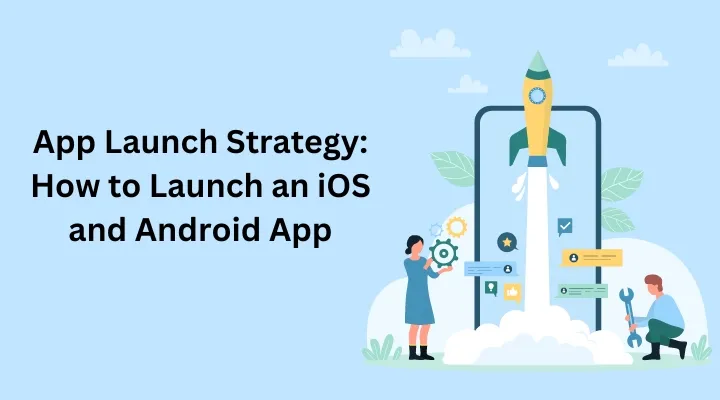App Launch Strategy: How to Launch an iOS and Android App

So, you've poured countless hours, late nights, and a whole lot of sweat into developing your brand-new mobile app. It's your brainchild, a masterpiece of innovation, designed to provide users with an unforgettable experience. But here's the real question: How do you ensure your creation doesn't just see the light of day but dazzles your target audience from the get-go? The answer lies in a well-thought-out app launch strategy that combines preparation, innovation, and a dash of marketing magic.
Buckle up as we guide you through the exhilarating journey of launching an iOS and Android app that commands attention and delivers results.
The Prelude: Preparing for Launch
Before you hit the launch button, it's crucial to lay the groundwork. Consider this the prelude to your app's grand symphony. Here's how to kickstart your app launch with panache:
Know Your Audience Inside Out
Don't throw your app into the wild without knowing exactly who will be using it. Conduct in-depth market research to identify your target audience's preferences, pain points, and behavior patterns. This knowledge will shape your marketing strategies and app features. For instance, Ola leveraged data analytics to understand user preferences, which led to their "Micro" offering.
Polish Every Pixel: Beta Testing
Beta testing is your app's dress rehearsal. Invite a select group of users to test your app's functionality, usability, and performance. Their feedback is invaluable in ironing out glitches and ensuring a seamless user experience. According to a report by TechCrunch, 80% of app crashes are reported by less than 1% of users. Swiggy refined its interface and improved order accuracy based on user input.
The Showtime: Launch Day and Beyond
It's time to roll out the red carpet and make your app's debut. But remember, the launch isn't a one-day affair—it's a well-orchestrated sequence of events.
Create Buzz with a Countdown
Tease your audience with a countdown to the launch date. This builds anticipation and gives you an opportunity to engage with potential users. Just like Amazon does during their Prime Day deals, creating a sense of urgency.
Charm the App Store Gods
Your app's store presence matters. Optimize your app's title, description, keywords, and visuals to ensure it's easily discoverable. SplitMetrics conducted a study that revealed a direct correlation between ASO and conversion rates. Optimizing your app's icon, screenshots, and description can lead to a significant increase in conversion rates. This is where you make your first impression, so make it count. Zomato's captivating app visuals and descriptions entice users to explore their platform.
Leverage Social Media Magic
Your social media platforms are your megaphone. A report by Think with Google states that 40% of users discover apps through app store searches, while 27% discover them through search engines and 14% through social media.Craft visually appealing posts, teasers, and behind-the-scenes content to create a buzz that resonates with your target audience. Make it interactive, like how Flipkart engages users with quiz-style posts. Collaborating with influencers can give your app launch the momentum it needs. Partner with influencers who align with your app's theme and let them introduce your app to their engaged followers.
The Curtain Call: Post-Launch Strategies
You've successfully launched your app—congrats! But your journey doesn't end here. Post-launch strategies are as important as the launch itself. Data from Localytics shows that after 90 days, the average app retention rate drops to just 34%. Effective post-launch strategies, such as push notifications and personalized content, can help improve retention.
Act on User Feedback
Keep your ears open for user feedback and reviews. Address concerns, fix issues, and make improvements based on your users' insights. This iterative approach shows your commitment to providing an exceptional experience.
Measure and Optimize
Dive into analytics to understand how users are interacting with your app. Which features are they loving? Where are they dropping off? These insights will guide your optimization efforts. Business of Apps reported that the cost of retaining an existing user is 5-7 times less than acquiring a new one. Post-launch strategies focused on user satisfaction can lead to long-term loyalty.
Elevate App Visibility
In the competitive app landscape, App Store Optimization (ASO) plays a vital role in driving app discoverability. ASO involves refining your app's store presence with strategic use of keywords, compelling descriptions, captivating visuals, and positive reviews. By optimizing your app for app store search algorithms and user preferences, ASO can significantly enhance your app's chances of being found and downloaded by potential users. According to a survey conducted by StoreMaven, apps that invest in comprehensive ASO strategies experience an average increase of up to 35% in organic downloads.
FAQs
Q1: Should I launch on both iOS and Android simultaneously?
Yes, launching on both platforms simultaneously is generally recommended. This ensures a wider reach and prevents users from feeling left out.
Q2: How do I stand out in the crowded app market?
Uniqueness is key. Identify what sets your app apart from competitors and highlight that in your marketing. Also, focusing on solving a specific problem resonates better with users.
Q3: What's the role of ASO (App Store Optimization) in launch strategy?
ASO is like SEO for apps. It involves optimizing your app's metadata to increase visibility and downloads. An effective ASO strategy can significantly boost your app's discoverability.